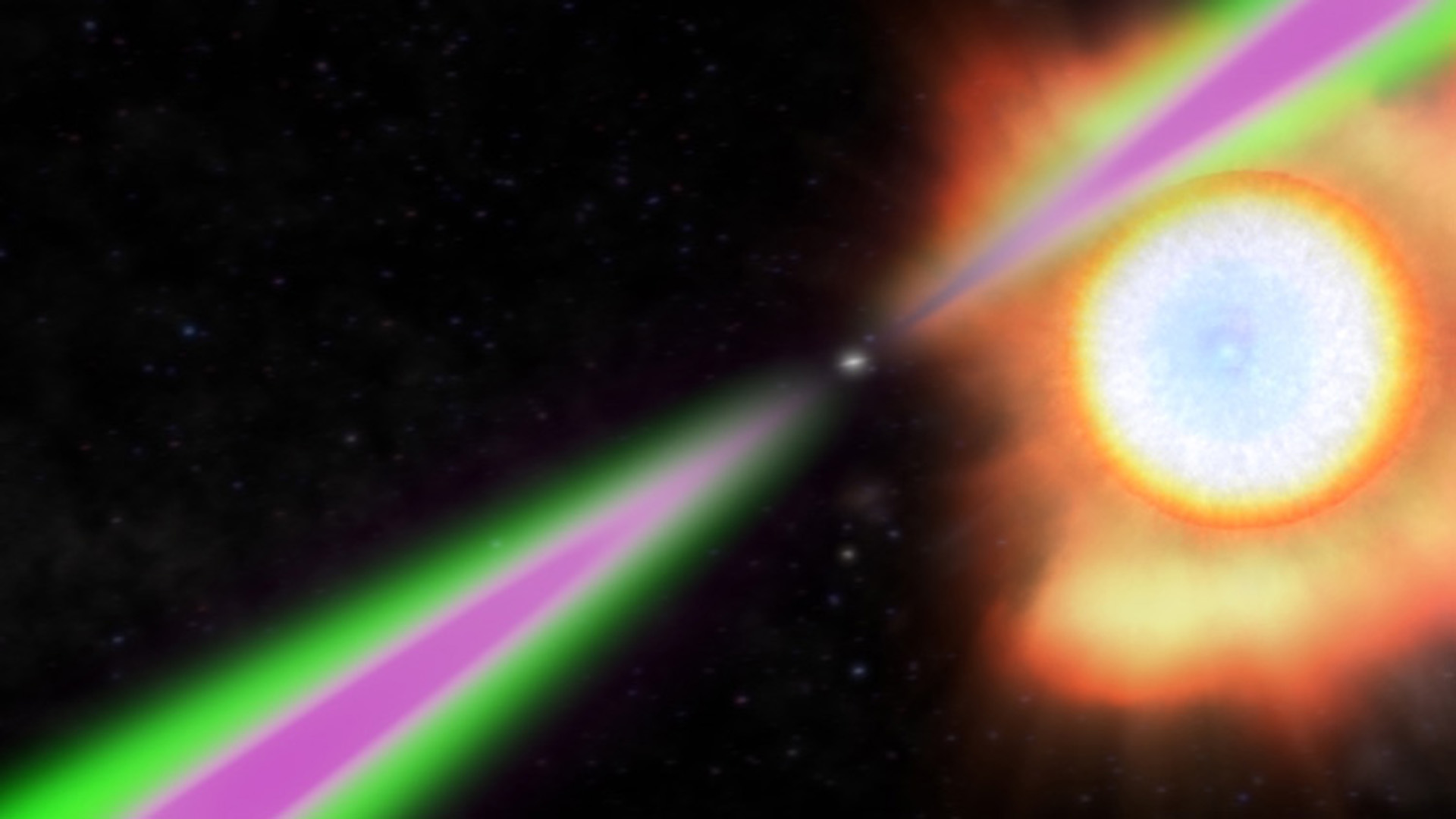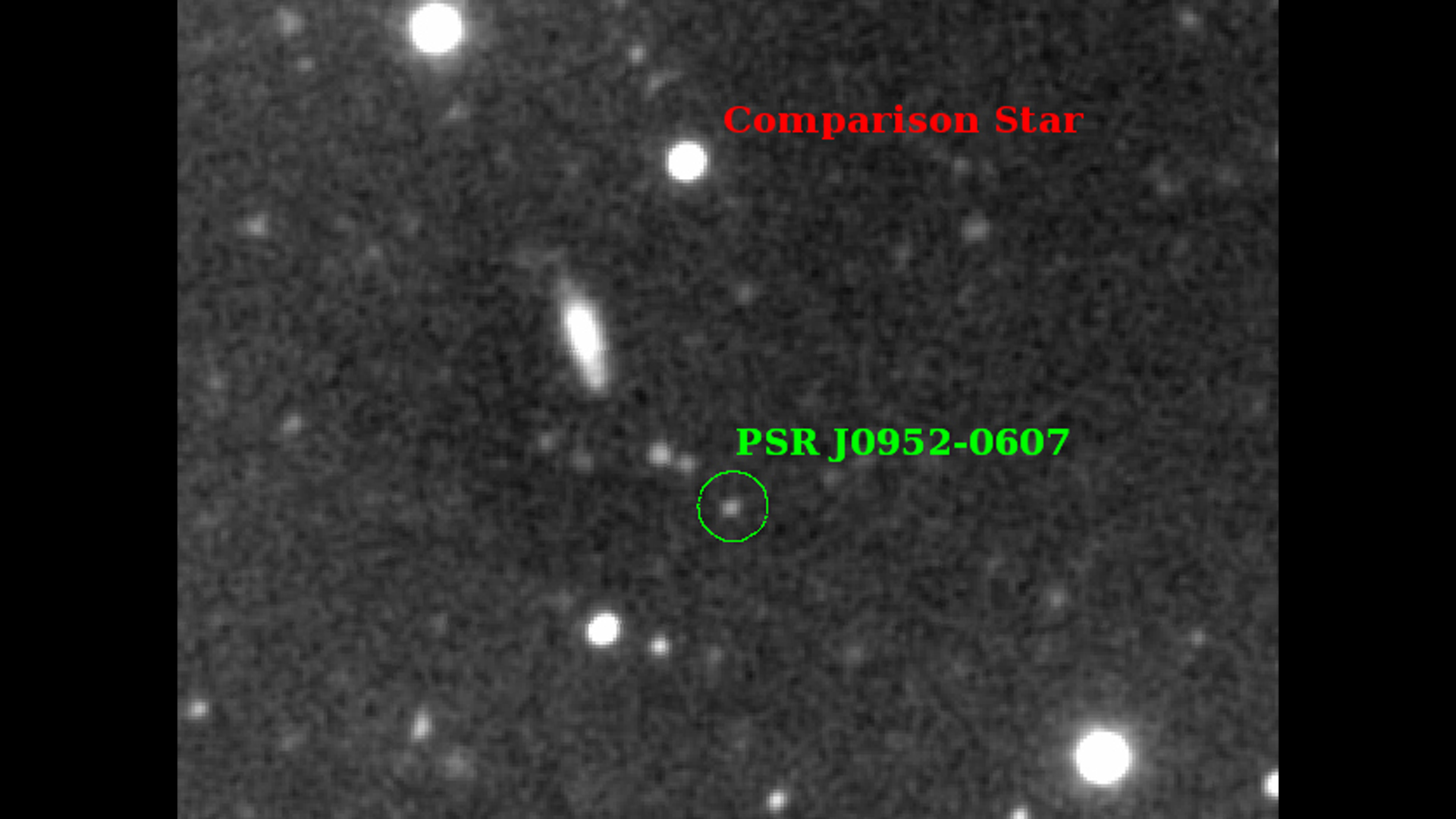The heaviest neutron star ever observed is shredding its companion
The stars help astronomers estimate when neutron stars collapse into black holes.

The heaviest neutron star ever detected is shredding its companion while spinning on its axis over 700 times per second.
The neutron star, known as PSR J0952-0607, was discovered in 2017 about 3,000 light-years from Earth in the constellation Sextans. Recent measurements show the star weighs 2.35 times as much as the sun, which makes it the heaviest neutron star known.
Neutron stars are stellar corpses, remnants of supernova explosions left behind when giant stars die after they run out of fuel in their cores. These stars, while only a few miles wide, boast the mass of the entire sun and more, making them the densest known objects in the universe apart from black holes.
Neutron stars are born spinning and can be detected only through beams of radio waves, X-rays and gamma rays, which they emit like cosmic light houses. Because of their blinking or pulsing nature, they are frequently referred to as pulsars.
Related: The first telescope of its kind will hunt for sources of gravitational waves
Most pulsars spin rather slowly, about once per second. PSR J0952-0607, on the other hand, completes over 700 rotations every second, which makes it one of the fastest spinning neutron stars known (in addition to being the heaviest). Thanks to its unique nature, PSR J0952-0607 can help scientists answer some profound questions about the nature of these puzzling objects.
Scientists, for example, think that when neutron stars get too heavy, they collapse onto themselves and turn into black holes. But they don't know at what mass this collapsing process takes place. They also don't understand the state of the matter inside of these stars, which are so dense that atoms likely cannot exist in their regular form inside them and instead get squashed into a soup of free-floating quarks (the constituents of protons and neutrons). The density of neutron stars is so high that one cubic inch (16 cubic centimeters) weighs over 10 billion tons.
Get the Space.com Newsletter
Breaking space news, the latest updates on rocket launches, skywatching events and more!
"We know roughly how matter behaves at nuclear densities, like in the nucleus of a uranium atom" Alex Filippenko, Distinguished Professor of Astronomy at the University of California, Berkeley and one of the authors of a study describing the star, said in a statement. "A neutron star is like one giant nucleus, but when you have one-and-a-half solar masses of this stuff, which is about 500,000 Earth masses of nuclei all clinging together, it's not at all clear how they will behave."

PSR J0952-0607 is part of a binary system known as a black widow pulsar. Named after the notorious black widow spiders, which consume their partners after mating, these systems consist of a neutron star that devours matter from a companion star. This infalling matter is responsible for the mind-boggling rotation speed of these pulsars.
The neutron stars at the heart of the black widow pulsars are quite difficult to study by themselves as they are extremely faint.
The astronomers were able to estimate the mass of PSR J0952-0607 by focusing on the remnants of the companion star, which has by now been reduced to the size of a large planet, about 20 times the size of Jupiter. Using the 3.2-feet (10 meters) W. M. Keck Observatory on Maunakea in Hawai'i, they were able to obtain spectra of the visible light emitted by the disappearing companion. By comparing the spectra to that of similar stars, they were able to measure the orbital velocity of the companion star and calculate the mass of the neutron star.
Filippenko and his colleague Roger W. Romani, a professor of astrophysics at Stanford University, have studied about a dozen black widow binary systems in recent years, but only six of them had a companion star bright enough to enable them to calculate the neutron star's mass.
"By combining this measurement with those of several other black widows, we show that neutron stars must reach at least this mass, 2.35 plus or minus 0.17 solar masses [before collapsing into black holes]," Romani said in the statement. "In turn, this provides some of the strongest constraints on the property of matter at several times the density seen in atomic nuclei. Indeed, many otherwise popular models of dense-matter physics are excluded by this result."
The study was accepted for publication in the journal Astrophysical Journal Letters and is currently available online through the repository Arxiv.
Follow Tereza Pultarova on Twitter @TerezaPultarova. Follow us on Twitter @Spacedotcom and on Facebook.
Join our Space Forums to keep talking space on the latest missions, night sky and more! And if you have a news tip, correction or comment, let us know at: community@space.com.

Tereza is a London-based science and technology journalist, aspiring fiction writer and amateur gymnast. Originally from Prague, the Czech Republic, she spent the first seven years of her career working as a reporter, script-writer and presenter for various TV programmes of the Czech Public Service Television. She later took a career break to pursue further education and added a Master's in Science from the International Space University, France, to her Bachelor's in Journalism and Master's in Cultural Anthropology from Prague's Charles University. She worked as a reporter at the Engineering and Technology magazine, freelanced for a range of publications including Live Science, Space.com, Professional Engineering, Via Satellite and Space News and served as a maternity cover science editor at the European Space Agency.









